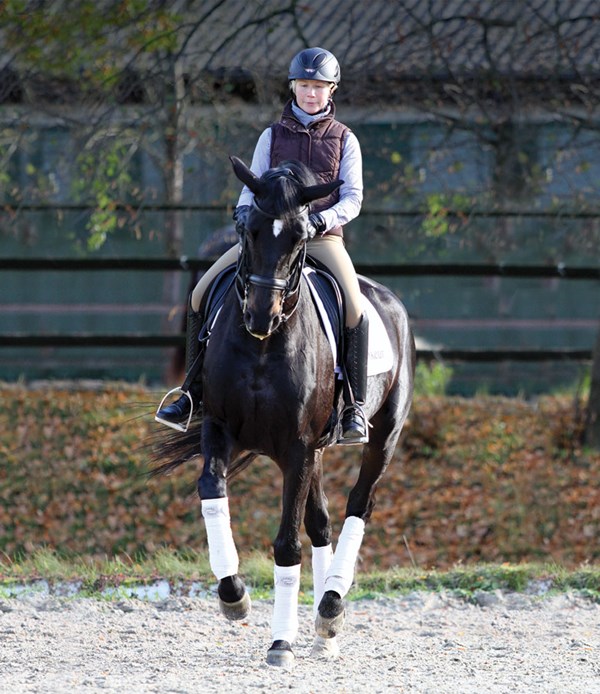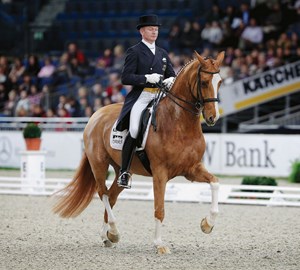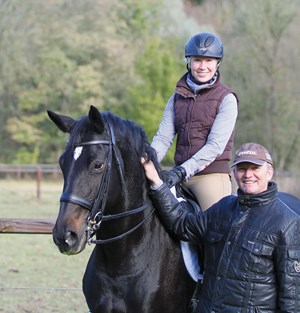
In last month’s article, we discussed the importance of the swinging collected trot in the development of piaffe (trot in place). As you start to develop passage (elevated, cadenced trot), you need that same swinging collected trot. From that trot, it’s easy to get passage. Your half halts make the trot shorter and shorter, without losing the swing or the activity, until you have passage. Later, after the horse has learned it, you can do passage from the walk.
The Aids

The primary passage aid is the deep leg and seat used together to push into a fixed rein aid (see rein aid 3 in “The Four Rein Aids” on the previous page). So to ask for passage from your active, swinging trot, you push with your seat and leg against your fixed hand that does not give. As a result, the horse’s hind legs engage and carry more weight, causing him to lift himself powerfully into passage. If you want a transition from passage to medium trot, you push and soften the hand (Rein Aid 1), and the horse swings and pushes more forward. Then, if you want a transition to an uphill passage again, you push against the fixed hand with Rein Aid 3. You hold the hand until your horse transfers the weight back and goes more uphill in passage. That’s the ideal, but if the horse isn’t perfectly through in the back, you may need to use the fourth rein aid: You bring your hand back and push with the seat and leg against it until the connection is made to the hindquarters, and the horse goes uphill. In this case, your horse must be thinking “forward” so he is responding well to the seat and leg, which are the primary aids.
Regularity of the Rhythm
In the beginning of your passage work, you don’t want high cadence; you only want to confirm the regularity. The worst problem you can have in the international Grand Prix is uneven steps in passage, so the absolute priority, in the beginning and always, must be regularity behind.
As my horse’s passage develops, I look for consistency with no uneven steps for half of a 20-meter circle. The steps of passage have to be exactly the same, not a long stride then a short one or a quick one and then a slow one. Even if the passage is a bit flat, we work to make it regular and consistent in the rhythm. When my horse can do a consistently correct half circle, then I can ask the passage to be a little more uphill, a bit shorter or with a bit more energy, but he must stay even and consistent in the rhythm.
Dealing with Passage Problems

When the horse isn’t thinking forward enough, it’s as serious a problem, as it is with piaffe. I do transitions forward and back to get my horse in front of my leg and wanting to go. Only then can I make the trot shorter without losing quality. Often the passage is best after a medium or extended trot because you can transform that pushing power into uphill carrying power.
If the horse’s hindquarters are out behind, you need to close his frame by using your leg.
Use the whip if you need to quicken the horse’s tempo.
As you know, regularity is the absolute priority. The uneven passage occurs because horses have a stiff side and a supple side by nature, and on the supple side the hind leg goes more forward than on the stiff side. That’s the source of unevenness in the passage, as it is in piaffe. Ninety-nine percent of horses step shorter on the stiff rein, which is usually the left, so the goal is to help him take the right rein so he can get softer on the left rein. You want him as even as possible on both reins. I achieve this by riding travers left on the long side, which not only makes the horse more equal in the reins, but it also puts the left hind in a position that makes it is easier for him to step forward.
In travers left, he doesn’t have to step under the heavy point with the inside (left) hind leg. Rather, the outside hind steps more to the heavy point, so it’s easier for him to step through with the left. When you go straight again, your horse will usually be more even.
When both piaffe and passage are very good, I continue confirming them for about a half year until I’m very satisfied with both. Only then do I start the transitions that are so important in the Grand Prix test: piaffe–passage–piaffe–passage.
Piaffe–Passage Transitions

The transition from passage to piaffe is the easier transition, but the horse’s challenge in this is to find the piaffe rhythm, which is almost always quicker. To ask for piaffe, bring your leg back a bit as a signal, and then ask for smaller steps by giving a small rein aid and pushing against it slightly. At this point, most horses need a moment to change from the slower passage rhythm to the quicker piaffe rhythm. I leave the horse alone for this moment. One of the most common mistakes riders make is that they push too much for piaffe. The pushing aid activates and improves the passage, but when you want piaffe, you need lighter aids. After I signal for piaffe, I leave him alone to find the quicker rhythm. Once he finds the rhythm, then I can use the leg a bit
to encourage him.
When it comes to the piaffe–passage transition, the most important thing is that the transition is fluid. The seat and leg push against the fixed hand, and the horse lifts and swings into passage. Again, that’s the ideal, but it takes awhile before the horse can actually passage directly from the piaffe.
So in the beginning, I think about trotting out for a few steps. Then as soon as he is out, I ask for passage again. We do piaffe, a few trot steps and then passage. Later, when the horse is stronger and more educated, we can do the transition piaffe–passage–piaffe smoothly. Those are the movements and the transitions that make the Grand Prix tests unique and beautiful.
The Four Rein Aids as Taught in Germany
1. The lightest rein aid is the softening rein. You do this, for example, when you are doing a transition from collected trot to a medium walk. You give the aid to walk and soften the hand so the horse follows and reaches into a less collected frame. You can do this best when the balance is perfect.
2. The next rein aid is simply a steady following contact, which is also used when the horse is in a perfect balance. The frame is perfect and you have a good connection in which both reins feel the same. It’s easy to sit quietly and just keep the rein contact.
3. The fixed rein is used when you are doing a transition to higher collection or when the horse gets a little strong in the hand. In these situations, you want to influence the hind legs by pushing with the seat and leg against a hand that does not go forward. This transforms the horse’s pushing power into carrying power. Then when the horse carries more weight behind, the center of gravity moves back and he gets softer and lighter in the hand. Then you have the possibility of softening the hand. This is the aid that you use in
the transition from collected trot
to passage.
4. The strongest rein aid is one in which the hand comes back. If the rein aid with the fixed hand doesn’t work and your horse is still too much on the hand or needs to bend more, then you need to use the strongest rein aid. In this case, you push against the hand that comes back until the horse connects and transfers his weight back. Then you can immediately soften the hand.
FEI Definitions of Passage and Piaffe

Passage
1. Passage is a measured, very collected, elevated and cadenced trot. It is characterized by a pronounced engagement of the hindquarters, a more accentuated flexion of the knees and hocks, and the graceful elasticity of the movement. Each diagonal pair of legs is raised and returned to the ground alternately, with cadence and a prolonged suspension.
2. In principle, the height of the toe of the raised forefoot should be level with the middle of the cannon bone of the other supporting foreleg. The toe of the raised hind foot should be slightly above the fetlock joint of the other supporting hind leg.
3. The neck should be raised and gracefully arched with the poll as the highest point and the nose line close to the vertical. The Horse should remain light, and soft “on the bit” without altering the cadence. The impulsion remains lively and pronounced.
4. Irregular steps with the hind or front legs, swinging the forehand or the hindquarters from one (1) side to the other, as well as jerky movements of the forelegs or the hind legs, dragging the hind legs or double beat in the moment of suspension are serious faults. The aim of passage is to demonstrate the highest degree of collection, cadence and suspension in the trot.
Piaffe
1. Piaffe is a highly collected, cadenced, elevated diagonal movement giving the impression of remaining in place. The horse’s back is supple and elastic. The hindquarters are lowered; the haunches with active hocks are well engaged, giving great freedom, lightness and mobility to the shoulders and forehand. Each diagonal pair of legs is raised and returned to the ground alternately, with spring and an even cadence.
2. In principle, the height of the toe of the raised forefoot should be level with the middle of the cannon bone of the other supporting foreleg. The toe of the raised hind foot should reach just above the fetlock joint of the other supporting hind leg.
3. The neck should be raised and gracefully arched, with the poll as the highest point. The Horse should remain “on the bit” with a supple poll, maintaining soft contact. The body of the Horse should move in a supple, cadenced and harmonious movement.
4. Piaffe must always be animated by a lively impulsion and characterized by perfect balance. While giving the impression of remaining in place, there may be a visible inclination to advance, this being displayed by the Horse’s eager acceptance to move forward as soon as it is asked.
5. Moving even slightly backwards, irregular or jerky steps with the hind or front legs, no clear diagonal steps, crossing either the fore or hind legs, or swinging either the forehand or the hindquarters from one side to the other, getting wide behind or in front, moving too much forward or double-beat rhythm are all serious faults. The aim of piaffe is to demonstrate the highest degree of collection while giving the impression of remaining in place.

Hubertus Schmidt is one of the most successful dressage riders in the world. He has trained dozens of horses to Grand Prix and influenced many of today’s top riders. Riding Wansuela Suerte, he was a member of the German team that won a gold medal at the 2004 Athens Olympic Games. The pair also won an individual silver medal at the European Championships the following year. His family-owned training facility, Fleyenhof, is in Paderborn, Germany.
Emma Kanerva, a native of Finland, was named Finnish Rider of the Year in 2004. She is assistant rider/trainer for Hubertus Schmidt. Although he is her greatest influence, Finnish Olympian Kyra Kyrklund is her idol.











